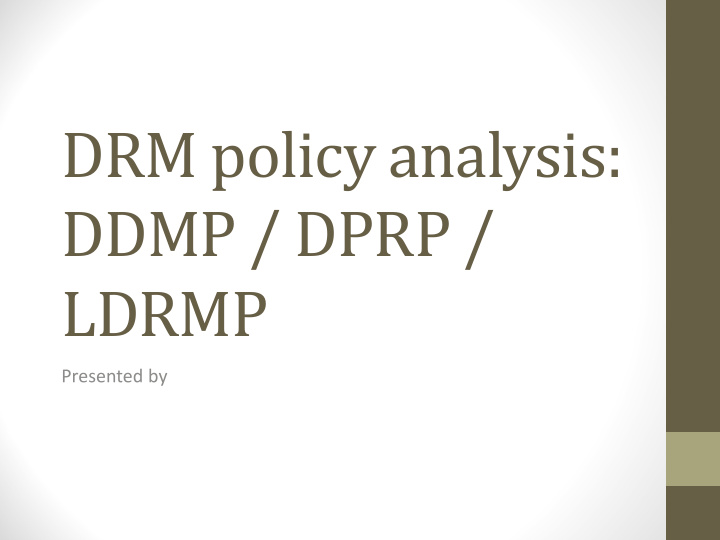



DRM policy analysis: DDMP / DPRP / LDRMP Presented by
Deliverable #1 Circulate by 12 January 2014 Present Monday 20 January 2014 – ½ day workshop including DDC (planning officer) and DAO (assistant CDO) DPRP • Praskah • Alex • ?WHO • Using the template DDMP • provided conduct a gap Asim • Dinanath • analysis of the allocated Kiriti • plan in 3 sections LDRMP • Rajan • 1. Stakeholders ?Kedar / CARE • 2. Processes Early Recovery Suman (UNDP) • 3. Information NSDRM Deepak • NDRF Becky-jay •
Plan name: • Which level of Government does it refer to? • How often should it be completed? • Approximately how many have been completed to date? • How does the plan link with the NSDRM?
Stakeholders • Which Government agency owns the policy • Who is involved in the planning process at: • District level • Other levels including VDC / municipality • In municipalities, how coordination different from VDCs? (try and map out who is involved in a diagram, including the levels)
Process Planning process • organisational structure Are these new organisational structures or existing? • • Specific committees established (at the various levels) Are these new or existing structures? • • Roles and responsibilities of stakeholders / committees • approvals process • what is the communication structure • Does the plan need to be activated? • What is the legal basis of the plan? • What resources are necessary for the planning process? • Funding • Trained human resources – how does this training occur? • How long does it take to complete a plan
Process….. Implementation • Who implements the plan? • Who is responsible for following up on implementation • Eg. What monitoring and evaluation is undertaken and by whom? • Where do the resources for implementation come from? Including funding and HR • How is the plan link to regular planning processes including the DDP or sectorial planning processes?
Information • Reporting • Where is the plan stored and by whom? • How do you gain access to the plan? • Can anyone implement activities in the plan? Does this happen or are plans repeated? • What is the awareness level of the plans existence by key Government stakeholders • How does the information reach the district and central level stakeholders? What recommendations do you have for improving this process? •
Information Risk assessment • What type of risk assessments is conducted? • Eg. Hazard analysis, vulnerability analysis • At what level eg. VDC, ward, district • What formulas (and assumptions) are used? • What is the feasibility of this being undertaken without external support ie. what is the replicability of the assessment? • Is there an analysis of the cost / effort involved in conducting the assessment eg. Assessment can be completed in 5 days by 4 trained people for 1 VDC? • How is the data gathered and by whom? How are these people trained • What institutional knowledge building is undertaken as part of this process eg. Is a • specific government person trained and appointment to undertaken this process on a regular basis? • Who owns the data and how is it used
Experience as a ……….. supporting partner • What has worked with the development of the plan: • including implementation • What would you recommend bringing forward • Eg. Basic risk assessment is seen as useful by all and there is buy-in by majority of stakeholders • What are the blockages for the plan during: • Planning process • Implementation process • Describe these in detail and provide examples Eg. Legal basis, lack of resources, lack of interest?
Experience as a ……….. Government stakeholder • What has worked with the development of the plan: • including implementation • What would you recommend bringing forward • Eg. Basic risk assessment is seen as useful by all and there is buy-in by majority of stakeholders • What are the blockages for the plan during: • Planning process • Implementation process • Describe these in detail and provide examples Eg. Legal basis, lack of resources, lack of interest? • How to do you / your ministry receive information about the plan? • What level of detail do is received?
Simplicity • Is it possible to simplify the plan? • If you had to prioritise 3 areas of the plan that are the most useful – what would they be? Variable Costs Benefits Basic risk assessment Restricted information Easy for Government collected and may officials to complete in a affect decision making short time capacity
Analysis • How does this plan link with the other 2 plans that are being examined? All presentations need to be submitted to Flagship 4 coordinator by 12 January and circulated to all. Flagship 4 coordinator will then put together a comparative analysis for the 20 January meeting.
Recommend
More recommend